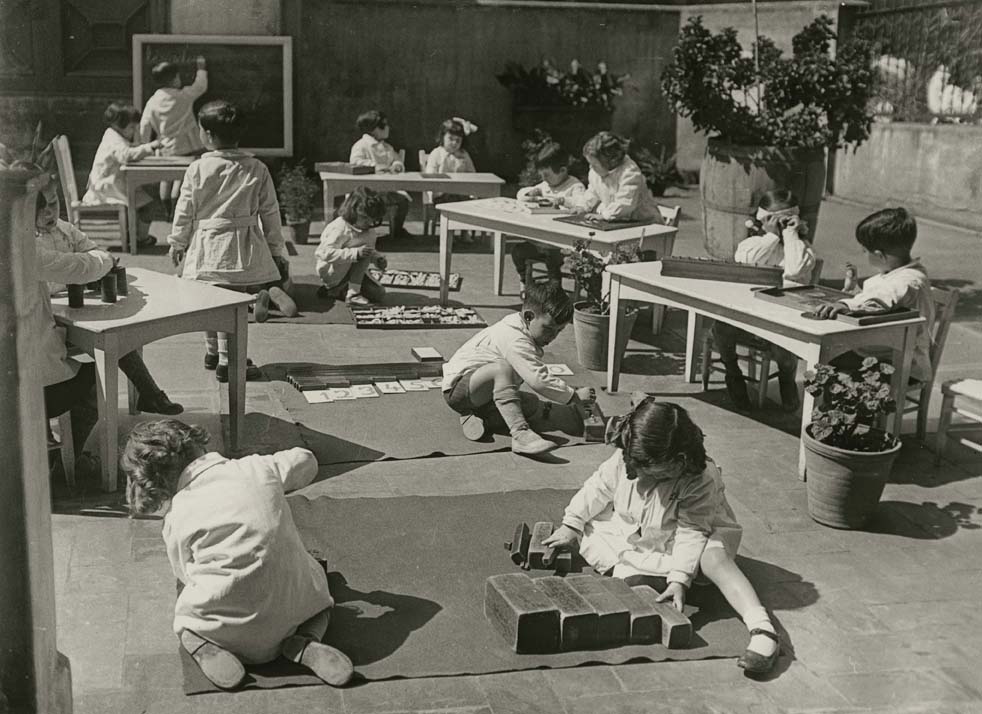Bienvenidos a mi Blog, espero que la información sea de tu agrado y sirva para conocer a los grandes revolucionarios de la educación de todas la épocas, mi nombre es Naomi García, estudiante del tercer semestre de la carrera de Pedagogía de la Lengua y Literatura de la Universidad Central del Ecuador.😊😊
María Montesori, revolucionando el Modelo Educativo del Siglo XX
María
Montessori nace en 1870 y muere en 1952, es una revolucionaria de la
educación del siglo XX, su intención era ofrecer a los niños y niñas una
educación "más respetuosa con sus intereses", más
atenta a ellos, por lo que diseña un entorno de aprendizaje hecho al
nivel de los niños. Es así que crea un ambiente único para los infantes,
todo es adecuado a su tamaño, las mesas, sillas, estanterias,
instalaciones sanitarias, entre otras, para garantizar una educación
enfocada en los niños.
La pedagogía de Montessori aparece en la primera mitad del siglo XX, cuando la ciencia comenzaba a descubrir a la infancia como una etapa propia, idiosincrásica, diferente de la adultez. Empezaba a dejar de considerarse a niñas y niños como adultos en miniatura.
Su formación en medicina -es la primera mujer italiana en licenciarse en medicina, en 1896- le lleva a preocuparse por la investigación
psiquiátrica para aplicarla a la infancia discapacitada, de ahí que, el
6 enero de 1907, cuando inaugura la primera «Casa dei Bambini»
San Lorenzo, su propuesta está más centrada en la infancia
discapacitada. Defiende con contundencia su confianza en que puede ser
educada y, por tanto, advierte del error en que caen aquellas maestras y
maestros que “les juzgan poco inteligentes e incapaces” (María
Montessori, 1982, pág. 248).
Lo interesante de este método, es que no está pensado solo para niños y niñas de 3 a 6 años de edad o solo para aquellos que sufren de alguna discapacidad, puesto que su aplicación es para estudiantes de otros niveles y con distintas capacidades. Otro dato interesante de Montessori, es que ella reelaboró la clasificación de la discapacidad mental de la época en una obra titulada "Normas para una clasificación de los deficientes en relación con los métodos especiales de educación" con el fin de dar a conocer la importancia de la educación a la infancia con discapacidad, ya que ella consideró que tienen mayores posibilidades intelectuales a lo que las personas consideraban inútiles, tambien expone la importancia de aplicar una educación más sentimental, que estimule, frene y guie las decisiones de voluntad del ser humano.(Cit. por Fulvio De Giorgi. En María Montessori, 2016, pág. 16).
Es una pedagogía puerocéntrica o paidocéntrica, pues el niño y la niña se convierten en el centro de toda la toma de decisiones para la educación. Una mirada y concepción revolucionaria frente a la educación tradicional, más dedicada a convertirlo en persona adulta y productiva, pero sin reconocerle una identidad como niña o niño y mucho menos unas necesidades específicas y una personalidad propia como niña o niño. Es un giro total, pero con el riesgo de olvidar que son personas que viven en sociedad.

Su modelo educativo considera como fundamental el desarrollo de los sentidos y de la motricidad de niñas y niños, respetando su ritmo interno de desarrollo, el aprendizaje del cálculo y el desarrollo del lenguaje.
Sus recursos didácticos son muy rígidos, dirigistas y autodisciplinantes, con una única manera correcta de utilización, pero atractivos y motivadores, ya que son adecuados en sus dimensiones, su tamaño, al desarrollo físico y motriz de las niñas y niños y, además, son de colores y materiales atractivos. Nada que ver con los materiales de las escuelas tradicionales en ese momento histórico.
Es un material educativo para trabajar de manera individual, que no exige necesariamente la colaboración de los demás niños y niñas. Cada estudiante tiene su propio espacio y materiales que los demás deben respetar, que no pueden utilizar salvo invitación expresa del propio niño o niña.
Su modelo de escuela recurre a una decoración estimulante al servicio de los aprendizajes; con aspecto agradable y colorido, luminosidad, variedad de materiales educativos estimulantes, frente a la pobreza de recursos de las escuelas públicas en aquel momento histórico.
En las aulas montessorianas todo está muy estructurado y organizado, pero generando la sensación en la infancia de que tiene verdadera libertad para elegir qué hacer, cuándo y cómo. En realidad, es una organización en la que el profesorado trata de prever, de adelantarse a tales elecciones.
Para no romper el ambiente alentador que debe envolver la vida infantil, María Montessori procura implicar a las familias en la educación de sus hijas e hijos, tratando de convencerlas de las bondades de la mayor coordinación posible con el profesorado. Una propuesta innovadora en aquellos tiempos y algo que considero realmente que merece la pena ser salvaguardado.
LOS CUATRO PERIDODOS QUE DETERMINA MONTESSORI
Mente absorvente del niño (de 0 a 6 años)

Perido de la niñez (de 6 a 12 años)
Adolescencia (de 12 a 18 años)
Pubertad (de 12 a 15 años): Nuevo
nacimiento, en el que ocurren cambios físicos y psicológicos del niño,
empiezan los sentimientos de duda, de inseguridad, explosiones
emocionales, entre otras.
Adolescencia (de 15 a 18 años):
Consolidación y crecimiento de intereses, donde aparece la inquietud
por la posición dentro del mundo adulto y hay myor compromiso con la
responsabilidad social.
Madurez (de 18 a 24 años): El jovén se adentra a la vida adulta, mantiene una estabilidad social y emocional
* * * *
(1). Grudzinska, Joanna (2016). Révolution école 1918 – 1939: quand l’utopie faisait école. Documental dirigido por Joanna Grudzinska. Producido por Arte France, Les Films du Poisson, Francia. Dur. 85 min. https://www.youtube.com/watch?v=xQcy8aAv1xY [A Revolução na escola 1918-1939 primeira parte]
https://www.elclubdeloslibrosperdidos.org/2018/06/los-4-planos-del-desarrollo-infantil.html






